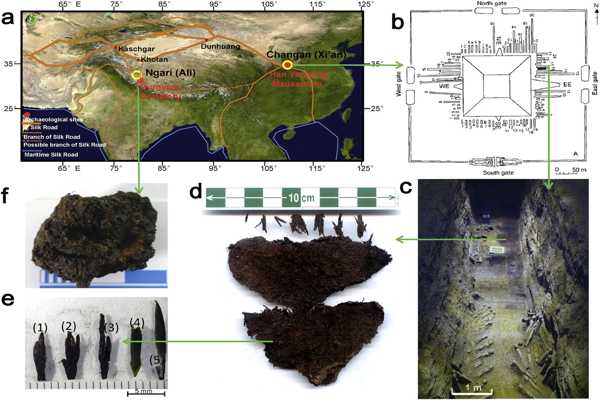A new optical dating technique was used by researchers to directly constrain the age of prehistoric stone artifacts from an archaeological site in southern Tibet. The discoveries date back more than 5,000 years, making them the oldest evidence of the human presence in this region of the Tibetan Plateau.
Humans and their ancestors have been making stone tools for millions of years. These rocky remnants – lithic artifacts and flakes – are extremely important to archaeologists. They are among the most common finds in archaeological excavations due to their high preservation potential. The numerical dating of these lithic artifacts remains a major challenge around the world, particularly when they are discovered as surface finds.
Stone tools, in general, cannot be directly dated unless they are embedded in sediment layers alongside organic material, for example. The radiocarbon technique can be used to constrain the age of such organic material. If such datable organic remains are absent, or if stone artifacts do not occur in a stratified sedimentary context, but rather as scattered surface artifacts, numerical dating becomes extremely difficult, if not impossible.
Researchers used a new optical dating technique to directly constrain the age of prehistoric stone artefacts from an archaeological site in southern Tibet. The findings are more than 5,000 years old and thus the oldest evidence of human presence in this part of the Tibetan Plateau.
“The earth’s surface is highly dynamic, and material erosion and redeposition are common, particularly over long timescales.” As a result, determining the precise age of lithic artifacts discovered as surface finds has been difficult so far. Many aspects of ancient human behavior have only been preserved as surface finds and thus cannot be precisely dated using current dating methods. We can now perform precise and direct age measurements on lithic artifacts for the first time thanks to further development of the Optically Stimulated Luminescence (OSL) dating technique.
“In our current study, we used stone artifacts from an archaeological surface site in south-central Tibet,” explains Michael Meyer, head of the Luminescence Laboratory at the University of Innsbruck’s Department of Geology and one of the study’s main authors. OSL dating is one of the most important absolute dating tools in archaeology and the earth sciences because it is based on the measurement of light stored in natural minerals.
“This dating technique employs natural light signals that accumulate over time in natural dosimeters such as quartz and feldspar grains, which are important constituents of sediments, as well as rocks and lithic artifacts. These minerals can be compared to miniature clocks. Each grain is a miniature clock that can be ‘read-out’ in a laboratory setting. We can infer the age of the archaeological sediment layer or artifact using the light signal. The older the sample, the more light it receives “according to the geologist “We have now taken a new approach in this study, focusing not on sediment grains of sand, but for the first time on stone artifacts themselves.”

Quarrying activities more than 5,000 years ago
Because of their harsh environmental and climatic conditions, the dry highlands of Tibet are thought to be one of the last human-occupied areas on the planet. Over the last decade, scientists have been debating when exactly people began to populate these remote and rather extreme environments. Michael Meyer dated the famous human foot and hand prints of Chusang in the central Tibetan plateau to between 8,000 and 12,000 years ago in 2017.
Meyer and his colleagues examined archaeological finds from southern Tibet in the Innsbruck OSL Laboratory for the current study: At an elevation of 4450 meters, the excavation site Su-re is located immediately north of the Mount Everest-Cho Oyu massif in the Tingri graben. Surface artifacts are very common in Tibet.
The researcher applied the “Rock Surface Burial Dating” technique to lithic surface artifacts to date them. This method determines when the stone artifact was abandoned by humans and at least partially covered by earth. ” We can look inside the stone using our luminescence method to create a continuous age-depth profile. Because the inside of a rock has never been exposed to sunlight, we have a saturated luminescence signal as well as an infinitely high age. However, if the rock surface is exposed to sunlight for an extended period of time, the signal in the top millimeters or centimeters of the rock is erased.
This occurs during knapping, when the stone tool is created, as well as during human use of the artifact. The luminescence signal in this artefact surface recharges when it is discarded and at least partially buried in sediment and shielded from light. We can calculate the age of the artefact discard by measuring this depth-dependent luminescence signal in the rock surfaces and accounting for the dynamics of local earth surface processes. “We can date stone artifacts directly using this method, even if they are surface finds,” Meyer explains.
Surface artifacts from southern Tibet were analyzed and found to be between 5,200 and 5,500 years old. “We believe the artifact discoveries at Su-re are related to quarrying activities at this site.” Although very old sites have been discovered in the central part of the Plateau, Su-re is currently the oldest securely dated site in the southern sector of the Tibetan Plateau.
The analysis of these Tibetan artefacts, according to Michael Meyer, is just the beginning: “This OSL-based method opens up new vistas in archaeological dating and holds great potential also for sites on other continents that preserve lithic artefacts in a favorable setting,” the geologist concludes.
















